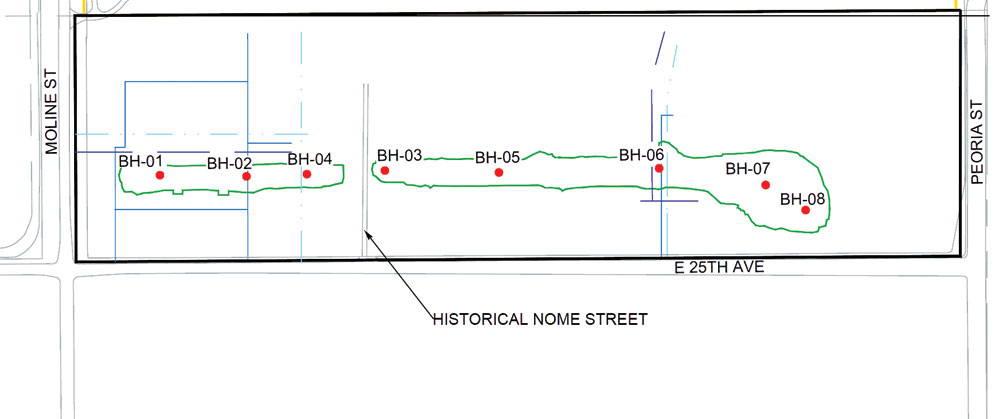
The “BH-01” and other BH labels indicate bore holes where the sampling was done. The green line indicates the approximate extent of the former Highline Canal.
Denver has decided to remove 40,000 cubic yards of concrete crusher fines fill material placed in Stapleton Aurora Filing No. 3 due to the presence of pollutants exceeding standards set for the redevelopment of the former Stapleton airport site. No date has been set for the removal and replacement although Denver has estimated the cost to be $1.2 million.
The affected area extends for 2,200 feet with a width of 50 feet (see figure). The crusher fines were buried under eight feet of clean soil. The depth of the crusher fines varied from 8 to 20 feet. The fill replaced soils contaminated during Denver’s ownership of the former airport. Pollutants included asbestos. The affected area is the site of a former lateral to the Highline Canal.
Denver Aviation spokesperson Heath Montgomery said the “airport made the decision to use the crusher fines because the material met the definition of soil and was an allowable material for the purpose. The crusher fines were being stored on site and was a readily available material, so it made sense to utilize it in support of our goal to invest for sustainable operations by recycling it.”
Denver said it received a request from Stapleton developer Forest City to “test this material based on potential concerns about the presence of heavy metals.” Forest City was performing regular due diligence prior to purchasing the property from Denver. An April 11, 2017 letter to Denver from Katy J. Dunn, Forest City assistant general counsel, said the request arose from their learning concrete crusher fines had been used as fill rather than soils. They requested “written confirmation that the ‘no action determination’ (“NAD”) issued for the site is not voided by this new information.”
An NAD was issued for the site by the Colorado Department of Health and Environment under its Voluntary Cleanup Program (VCUP). CDPHE operates the VCUP under an agreement with the Environmental Protection Agency to encourage the voluntary cleanup of brownfields such as the former Stapleton Airport.
When testing found exceedances for polycyclic aromatic hydrocarbons (PAHs), CDPHE’s Fonda Apostolopoulos issued a May 10 letter to Denver stating the contaminated fill material would have to be removed and replaced if it wished to receive a letter from the state indicating the site is suitable for “Unrestricted Use.” That letter is crucial to lenders who might be underwriting residential development. Under the VCUP, CDPHE couldn’t compel Denver to remove the fill. Denver’s other option was to leave the fill in place and make development of the property subject to an environmental covenant prohibiting residential uses. That was unacceptable to Forest City.
The consultant that prepared the sampling and analysis of the fill material, Brown and Caldwell, speculates that the concrete crusher fines were contaminated by a nearby asphaltic concrete pile. Both piles originated with materials recycled from the former airport. Denver aviation spokesperson Heath Montgomery said, “It’s important to note that while the levels of the chemicals discovered exceeded the allowable levels within the agreement, they are commonly found in asphalt.”
Apostolopoulos said placement of the contaminated fill appears to have been an “honest mistake” on Denver’s part, noting that this is the first time in working with Denver on Stapleton remediation over 15 years that anything like this has happened.



0 Comments